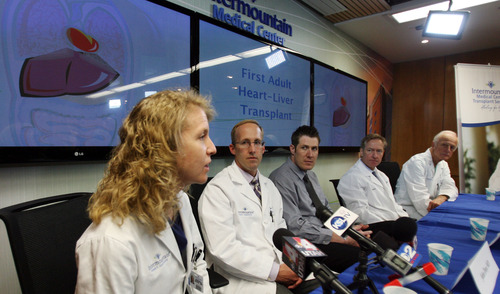This is an archived article that was published on sltrib.com in 2013, and information in the article may be outdated. It is provided only for personal research purposes and may not be reprinted.
Mike Mader can't quite remember just how many heart attacks he had.
The first came about nine years ago, when Mader was just 22. After that, there were 15 or 16 more.
"I kind of lost track," he said jokingly on Thursday. "At one point, I think just over 35 coronary stents were placed in me. It's been challenging. I never knew what to expect."
But doctors at Intermountain Medical Center in April performed a combined heart-liver transplant for the 31-year-old West Jordan man, promising him a healthy future. It was the first procedure of its kind performed on an adult patient in the Intermountain states of Utah, Idaho, Nevada and Wyoming.
Mader's heart problems were tied to his liver and stem from a rare genetic disorder called familial hypercholesterolemia, characterized by high levels of bad cholesterol in the blood and early heart disease.
Some patients, such as Mader's sister, who also suffers from the disease, can effectively manage the condition through medication and other treatments. But those options never worked for Mader.
About 30 medical centers nationwide do the same heart-liver transplant Mader had, but most hospitals do only one procedure each year. Data from the United Network for Organ Sharing shows 22 of the transplants were done in 2012.
On Thursday, Mader's Intermountain doctors said they know of only one other Utah patient in need of the heart-liver transplant.
The procedure requires a highly trained medical team, meticulous planning and a bit of luck — a viable set of organs must become available at the same time. Doctors would also prefer the heart and liver come from the same donor, which was the case with Mader, to reduce the range of post-surgery complications, including rejection.
Mader spent 718 days on the transplant waiting list before having surgery on April 23. He was discharged from the hospital on May 6, but will need follow up care for many months to come.
The surgery began with the heart transplant, which took about four hours, said surgeon John Doty, who put in Mader's new heart. Then a second team of doctors took over for the liver transplant, which takes roughly another four hours, surgeon Willem Van der Werf said.
Both procedures are complicated, and doing them together is a testament to the quality of Intermountain's transplant program, said surgeon Kent Jones.
"I can't tell you the hours that went into the planning of this and the game plan," he said. "It was monumental, and it involved hundreds of people."
Mader's mother, Susan Mader Nab, said the surgery was the miracle she had long prayed for.
"Right away he was feeling better," said Nab, who herself had a seven-artery bypass surgery and lost her sister and mother to heart attacks. "The first thing he said when he woke up was that he couldn't believe how sick he had been and how much better he already felt."
Mader said he immediately felt more energetic, isn't out of breath, sleeps better and even thinks more clearly.
"I could go on for hours about the little differences," he said, adding that he's looking forward to traveling, going back to school and working again, something he hasn't been able to do since that first heart attack.
Mader's doctors said they did a double take when Mader showed up for Thursday's news conference looking fit and healthy.
"Can I just put in a plug for organ transplants?" Doty said. "We have a young man sitting here who has the gift of two organs from a family that was kind enough to give the gift of life. And he looks terrific. If you pass him on the street you won't know he had a transplant."
Mader thanked the donor family who graciously gave him his new heart and liver.
"I feel bad for the family, but I just can't thank them enough," he said. "They saved my life."
Heart-liver transplants remain rare
Nationally, the combined heat-liver transplant is about as rare as Mike Madar's genetic disease.
Data from the United Network for Organ Sharing (UNOS), which manages the nation's organ transplant system for the federal government, shows that just 132 such procedures have been performed on adults and children between January 1988 and February 2103.
Primary Children's Medical Center in Salt Lake City performed a combined heart-liver transplant for a 13-year-old Arizona boy last year, the first such procedure at the center.
Nearly 120,000 people are list on the national transplant waiting list. About 92 a day get transplants, but another 18 die, according to UNOS data.









